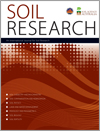We evaluated the influence of intercropping maize with forage grasses of the genus Megathyrsus and Urochloa on soil properties and on yield of succeeding soybean (Glycine max) in the Cerrado of north-east Brazil. Intercropping maize with forage grasses of the genus Urochloa increased soil humic substances and carbon concentrations, whereas intercropping maize with species of the genus Megathyrsus improved the soil chemical and biological attributes. Average soybean yield was 15% higher when cultivated following maize + forage grasses, compared to monoculture maize.

Volume 62 Number 5 2024
Soil organic matter (SOM), carbon (C), and nitrogen (N) management is critical for successful forest restoration. Our study investigated SOM, C, and N in forest soils following the restoration of one of the world’s most industrially degraded landscapes. We found that despite immense degradation, 20-years post-restoration SOM, C, and N relationships, and how they change with soil depth, closely resembled those of unimpacted forested sites, suggesting that regardless the level of degradation restoring soil structure and function is possible.
Sheep rotational grazing is an important strategy to reduce carbon dioxide emission and improve soil organic carbon storage of spring wheat fields in an arid region.
We investigated the effects of undulating landscape strata on the response of wheat to fertiliser application, water productivity, and soil properties. Landscape position dictates the soil properties and the extent of wheat yield response to fertiliser application. Significant differences were found in wheat response to fertiliser application and soil nutrient status among landscape positions. Hence, considering landscape position will help understand its implication on soil variability and crop response to fertiliser application in farms with undulating landscape features.
Soil moisture sensing enables precision capability to manage crop productivity. We designed and implemented a spatial, vertical and temporal model for mapping soil moisture at the farm level. Upscaling data from soil probes to the farm level provides better insights about fluxes of soil moisture. Our on-farm soil moisture monitoring system is modular, with each component that can be readily updated and improved. Soil moisture monitoring networks cannot be set-and-forget systems, but require longer term planning and monitoring.
SR24004 Abstract | SR24004 Full Text | SR24004PDF (6.5 MB) Open Access Article
Soils can increase in carbon and mitigate greenhouse gas emissions. This study assessed the potential of soils to increase in soil carbon at the farm scale. Soil type and mineral surface area were the main drivers for differences in the carbon sequestration potential at the farm scale. An understanding of the distribution of this potential at the farm scale could allow for targeted management practices to increase SOC.
SR23177 Abstract | SR23177 Full Text | SR23177PDF (2.7 MB) Open Access Article
Soil quality (SQ) sheds light on soil health and its capacity to sustain food and fibre production. It can assist decision-making in farming systems by integrating plant production into soil management planning. However, the use of cover crops can influence the SQ. For development of SQ models, the current study focussed on the monocropping system of cover crops. The main aim of this study was to assess the influence of cover crops on soil chemical properties, SQ, and its decay rate.
As part of global efforts to restore forests and combat climate change, our study investigates young forest restoration plantings in northern New Zealand. Spatial variation in soil, vegetation, and carbon storage across a small hillslope area showed that several topographical, soil- and vegetation-related characteristics significantly influenced soil carbon stocks. This discovery underscores the crucial role of landscape characteristics in shaping the success of forest restoration initiatives, emphasising the need for thoughtful planning that incorporates the unique features of each terrain.
SR24012 Abstract | SR24012 Full Text | SR24012PDF (3 MB) | SR24012Supplementary Material (2.6 MB) Open Access Article
Enhancing the mobilisation of soil legacy phosphorus to increase phosphorus use efficiency in agroecosystems may be very important, while phosphorus reserves will be depleted within 100 years. The studied green manures have rapidly mobilised different soil phosphorus pools. Therefore, the green manures may convert less labile soil phosphorus into more labile forms for the main crops, leading to a reduction of phosphorus inputs.
SR22257 Abstract | SR22257 Full Text | SR22257PDF (874 KB) | SR22257Supplementary Material (979 KB) Open Access Article
Formation of lower solubility ammonium salts may be a simple and cost-effective way to slow the release of nitrogen from fertiliser. Several modified mono-ammonium phosphate (MAP) fertiliser compounds were prepared by adding magnesium silicate to regular MAP fertiliser and reconstituting the granules. Shoot yields were lower when barley (Hordeum vulgare) plants were grown with the modified MAP fertiliser compounds compared to standard MAP fertiliser. This reduced growth was likely due to decreased nitrogen availability through a slower release of nitrogen.
SR24010 Abstract | SR24010 Full Text | SR24010PDF (376 KB) Open Access Article




